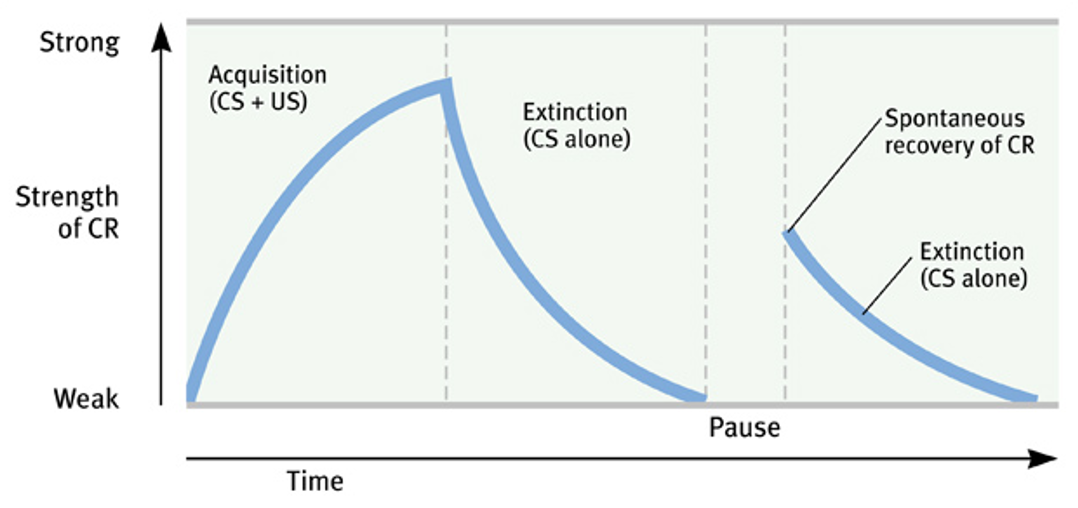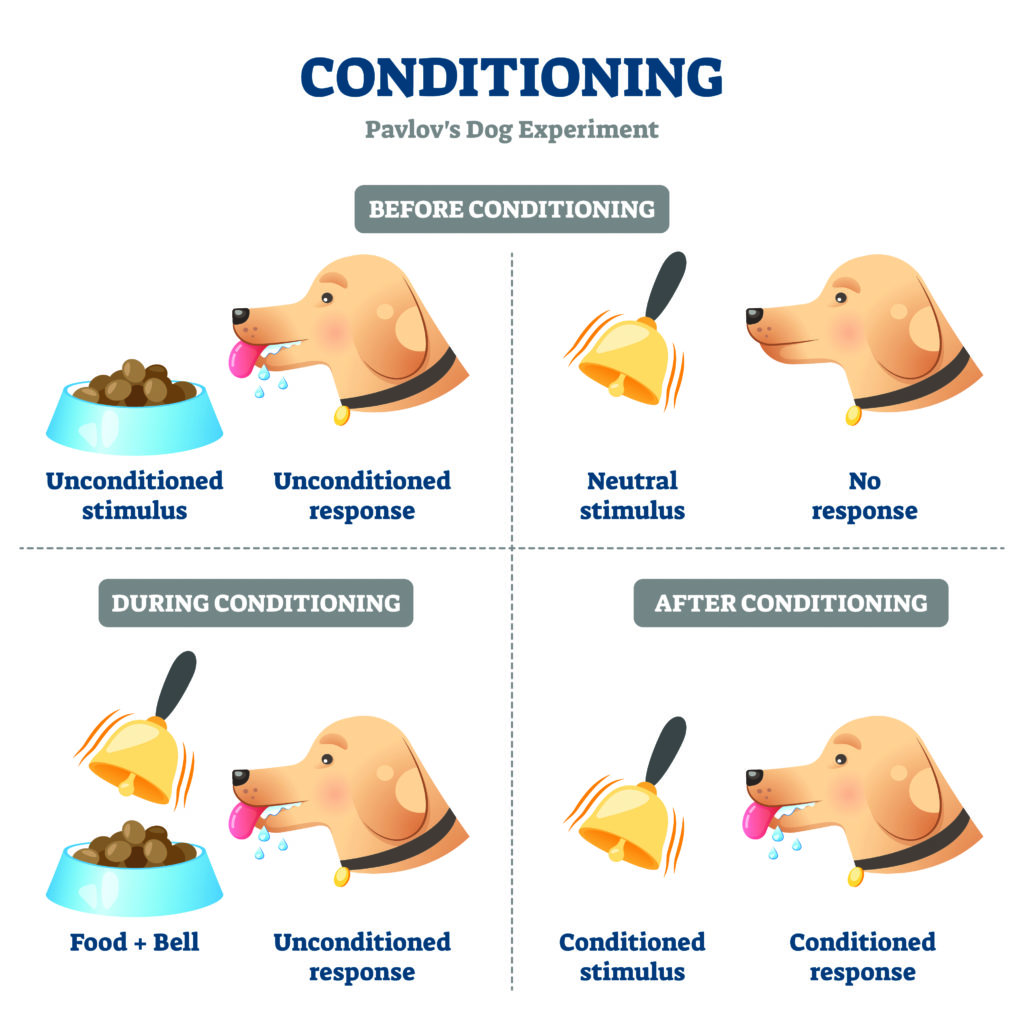Classical Conditioning
1/16
There's no tags or description
Looks like no tags are added yet.
Name | Mastery | Learn | Test | Matching | Spaced |
|---|
No study sessions yet.
17 Terms
Learning
Any relatively permanent change in behaviour brought about by experience or practice
Classical Conditioning
A form of learning that occurs through the repeated association of 2 or more different stimuli.
..
Learning is only said to have occurred when a particular stimulus consistently produces a response that it did not previously produce.
..
In classical conditioning, a response that is automatically produced by one stimulus becomes associated, or linked, with another stimulus that would not normally produce this response.
Key elements of Classical Conditioning
There are 5 key elements that are used to describe the process of classical conditioning
.
These include
Neutral Stimulus
Unconditional Stimulus
Unconditional Response
Conditioned Stimulus
Conditioned Response
Neutral Stimulus
The neutral stimulus (NS) is a stimulus that initially does not evoke a response until it is paired with the unconditioned stimulus.
Unconditional Stimulus
The unconditioned stimulus (UCS) is any stimulus that consistently produces a particular, naturally occurring, automatic response.
Unconditional Response
The unconditioned response (UCR) is the response that occurs automatically when the UCS is presented.
.
A UCR is a reflexive, involuntary response.
Conditioned Stimulus
The conditioned stimulus (CS) is the stimulus that is neutral at the start of the conditioning process and does not normally produce the UCR.
.
Yet, through repeated association with the UCS, the CS triggers a very similar response to that caused by the UCS.
Conditioned Response
The conditioned response (CR) is the learned response that is produced by the CS.
.
The CR occurs after the CS has been associated with the UCS.
.
The behaviour involved in a CR is very similar to that of the UCR, but it is triggered by the CS alone.
Key Processes in Classical Conditioning
Pavlov distinguished several key processes that are involved in classical conditioning.
...
These are known as acquisition, extinction, stimulus generalisation, stimulus discrimination and spontaneous recovery.

Acquisition
Acquisition is the overall process during which the organism learns to associate 2 events.
.
The rate of learning is often very fast in the early stages of the acquisition phase.
.
Timing is critical – US & CS need to be paired simultaneously or very close together for an association to form.
Extinction
Extinction is the gradual decrease in the strength or rate of a CR that occurs when the UCS is no longer presented.
.
Extinction is said to have occurred when a CR no longer occurs following presentation of the CS.
Spontaneous Recovery
Spontaneous recovery is the reappearance of a CR when the CS is presented, following a rest period after the CR appears to be extinct
.
Doesn’t not always occur and when it does it is often short-lived.
.
The CR tends to be weaker than it was originally.
Stimulus Generalisation
The tendency for another stimulus to produce a response that is similar to the CR.
.
The greater the similarity between stimuli, the greater the possibility that a generalisation will occur.
Stimulus Discrimination
Occurs when a person or animal responds to the CS only, but not to any other stimulus that is similar to the CS
Pavlov (1902)
Aim
Investigate the function of the brain in animals in their adaption to the external environment.
...
Participants
At least 35 dogs (of various breeds and ages), researcher
..
Materials
Metronome, container of meat, observing screen, tube for saliva collection, device to count saliva drops, dog harness.
..
Design
Independent variable was type of stimulus pairing, dependent variable was amount of saliva.
.
Method
Dogs individually situated in secluded environments and secured in harness.
.Food bowl was positioned in front of the dogs and a device was employed to gauge the frequency of salivary gland secretion
.
Data from measurements systematically recorded onto a rotating drum allowing Pavlov to meticulously monitor the rates of salivation throughout the course of experiments.
.
Food was unconditioned stimulus and salivation was unconditioned response
.
Pavlov used a metronome as his neutral stimulus and he began conditioning procedure, by clicking the metronome just before he gave food to the dogs.
.After several repeat trials of this procedure, he presented the metronome on its own and he measured the conditioned response (saliva produced)
.
Key Findings
Provided empirical evidence that behaviours were learned through classical conditioning – the conditioned response (salivation) to a neutral stimulus (metronome)
.Further experiments discovered other processes involved in classical conditioning - Generalisation, Discrimination, Extinction, Spontaneous Recovery
.
Contributions
Provides an explanation for how phobias can be acquired.
.Techniques based on classical conditioning, such as systematic desensitisation, have been developed to treat a variety of psychological disorders, including phobias.
.Marketing and advertising utilise classical conditioning principles to build positive associations for brands.
.
Limitations
Use of animals in research; results from dogs cannot be generalised to the human population plus aspects of Pavlov’s method would not be considered ethical according today’s standards.
.Ignores the role of cognitive and biological factors which have also been shown to play a role in learning.
..
Limited to explaining how reflex responses become associated with new stimuli and doesn’t fully explain more complex learning processes.

Little Albert (Watson and Rayner, 1920)
Aim
To investigate whether classical conditioning works on humans, specifically the acquisition of a fear a response and whether the response can be generalised.
.
Participants
9 month old boy Albert Barger (Little Albert).
.
Materials
White rat, rabbit, dog, monkey, burning newspaper.
.
Method
Baseline session - test Albert’s response to neutral stimuli. He was shown rabbit, rat, monkey, fire. He was unafraid of all.
..
Two months after the baseline session Albert was subjected during two conditioning sessions spaced one week apart to a total of seven pairings of a white rat followed by the sound of a steel bar being struck with a hammer which made him cry
..
Albert was then presented with the rat without the hammer sound at the end of the second session.
...
Followed by three transfer sessions.
..
1st Transfer session – Albert shown rat to assess maintained fear as well as other furry objects (fur coat, cotton wool, Santa mask) to test generalisation.
.2nd Transfer session – Included two additional conditioning trials with the rat to ‘freshen up the reaction’ as well as conditioning trials in which a dog and a rabbit were also paired with loud noise.
..
Extinction had begun to occur however association could be renewed by repeating original procedure a few times.
..
Found that fear was generalised to other stimuli like rat.
.
3rd Transfer session – Occurred after a month to test maintained fear. Albert and his mother withdrew from experiment which prevented Watson and Rayner from carrying out their original intention of deconditioning the fear they had conditioned.
...
Key Findings
Showed that a fear response could be conditioned - ‘Albert began to crawl away so rapidly that he was caught with difficulty before reaching the edge of the table.’
.Found the conditioned fear response could be generalised
..
Contributions
Provides empirical evidence that classical conditioning can be applied to humans.
..The methodology utilised standardised procedures and were taped, so the experiment can still be viewed and analysed today.
..
Limitations
Ethical considerations – violated protection from harm and potential issues around voluntary participation as Albert’s mother worked for the researchers.
....Data was subjective and may be vulnerable to experimenter effects.
..Albert’s reactions were inconsistent – if the researchers didn’t control for Albert sucking his thumb, the fear response didn’t appear.
....
Results may not be generalisable due to only one participant, a lack of control group and the methodological issues mentioned above.
Systematic Desensitisation
Syllabus point
Application and Evaluation of Learning Theories in Behaviour Modification
..
Developed by Wolpe – designed to treat phobias
.
Based on Classical Conditioning
Pairs phobia producing stimulus with relaxation techniques
.
3 Stages
1) The patient is taught relaxation techniques
(ie. Meditation, breathing exercises)
.
2) The patient creates a fear hierarchy
A list of stimuli (relating to the phobia) from one that causes the least anxiety to the one that causes the most
.
3) Patients then begin to go through the hierarchy, while practicing relaxation techniques
Patients stay at stages in the hierarchy until they feel no anxiety
.
Typically 4-6 sessions
More severe phobias can take more than 10
.
Exposure to stimuli can be in vitro (imagined) OR in vivo (actual exposure)
In vivo more effective
.
Strengths
Is supported by empirical evidence.
.
Limitations
In vitro exposure is may not be effective, and in vivo exposure is not always practical.
.
Treats the symptoms of the phobia and not the underlying cause, and doesn’t appear to be effective for social phobias